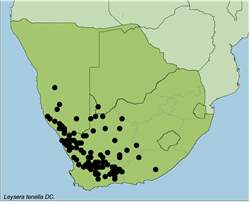Names and synonyms
Leysera tenella DC.
=Leyssera tenella DC. var. ?. subcanescens DC.
=Asteropterus tenellus (DC.) Rothmaler
=Leyssera tenella DC. var. ?. glabriuscula DC.
Type
Drege 6360, Cederbergen, 1833-12 (P)
Common names
Common wireweed; skilpadteebossie, vaalteebos
Derivation of names
Leysera = after German botanist, Friederich Wilhelm von Leysser (1731-1815), the author of Flora Halensis (1761).
tenellus = delicate; tenue - = slender, thin, narrow slender, tender, soft.
Diagnostic characters
Disc floret pappus consist of scales and a few bristles; ray floret pappus consist of scales only.
Pappus barbed in lower half, plumose above.
Solitary capitula on long pedicels
Description
A small, spreading annual or short-lived perennial herb, to 150(-200) mm tall, mostly delicate or sometimes more vigorous and branching mainly from the base, tomentose to almost hairless, glandular. Leaves laxly or densely set, sometimes almost crowded on short, brachyblasts present but mostly with leaves shorter than the subtending leaf, linear, 2-25 x 0.5-2 mm, greyish-tomentose to green and glabrescent, ventrally furrowed and somewhat tomentose, densely glandular. Capitula solitary, radiate, florets yellow. Peduncles smooth, wiry, 10-60 mm long, often at an angle to the main branch and the tip turned upwards. Involucre cup- to bell-shaped, 4-12(-15) mm wide. Involucral bracts 15-50, smooth, acute-obtuse; outer small and ovate; inner gradually longer and oblong with a scarious and often brown apical limb, 5-9 x 0.7-1.6 mm. Receptacle flat-convex, scabrid with small projections and furnished with a distal row of acute or apically laciniate, 0.8-4 mm long, persistent scales. Ray florets 8-35; tube glabrous or with scattered, multicellular hairs; lamina elliptic, 2-9 x 0.7-3 mm; cypselas 2.5-3.8 mm long, with twin hairs and often with a basal tuft of similar hairs, remaining clasped between the spreading receptacular scales and the innermost involucral bracts; pappus of short, flat, obtuse-truncate, white scales but with no bristles. Disc florets 20-175, perfect; corolla 2.6-4 mm long; tube with scattered, multicellular hairs and often with a collar of similar, densely set hairs just below the limb. Cypselas 2.5-3.8 mm long, glabrous or with few twin hairs and often with a basal tuft of similar hairs; pappus of short, flat, obtuse-truncate, white scales and 2-5 outer, basally barbellate and only apically plumose bristles.
Flowering time
Mainly from August to October but flowering specimens seen from the whole year.
Distribution
The species is rather common and widespread in southern Namibia, Namaqualand, and the Great Karoo to Willowmore. The northernmost locality is an outlier on Brandberg in northern Namibia.
Known from more than 150 specimens.
Habitat
Abundant in disturbed soils in most lowland habitat types, on sandy and stony flats.
Notes
This annual species is rather variable in size and habit, mostly due to environmental and climatological effects. There are all types: from small and delicate specimens to robust and vigorous plants, resembling the perennial L. gnaphalodes. The capitula are generally much smaller in L. tenella than in L. gnaphalodes. L. tenella can be distinguished by the sparser leaves that are more densely glandular, short brachyblasts, ray florets without bristles and the pappus bristles of disc florets that are plumose in the upper half only.
References
BREMER, K. 1978. The genus Leysera (Compositae). Botaniska Notiser 131: 369-383.
KESTING, D. & CLARKE, H. 2008. Botanical names, what they mean. Wild Flowers of the Cape Peninsula, 3rd revised edition. Friends of Silvermine.
LE ROUX, A. 2005. Namaqualand, South African Wild Flower Guide 1. Botanical Society of South Africa.
MANNING. J. 2007. Field Guide to Fynbos. Struik Publishers.
MANNING,J. 2003. Photographic Guide to the Wildflowers of South Africa. Briza Publications.
VLOK, J. & SCHUTTE-VLOK, A L. 2010. Plants of the Klein Karoo. Umdaus Press

_sml.jpg)
_sml.jpg)